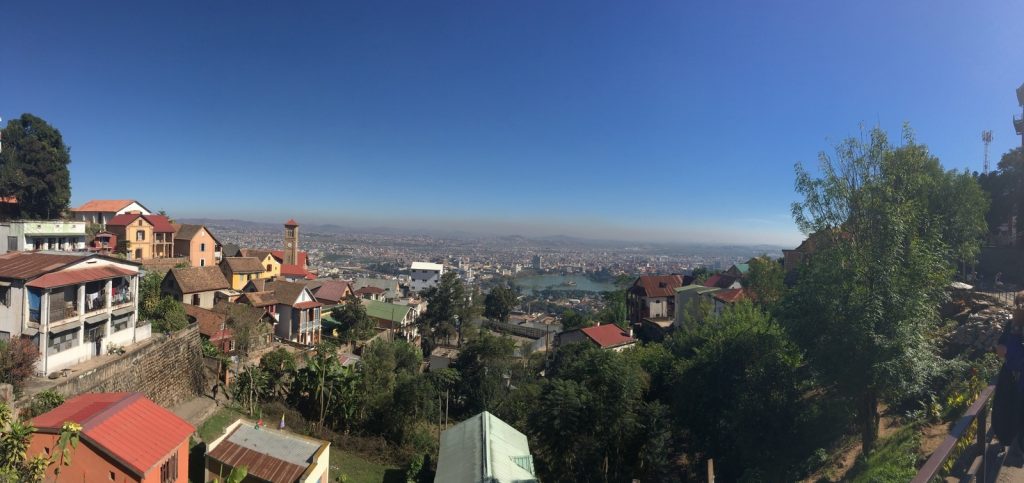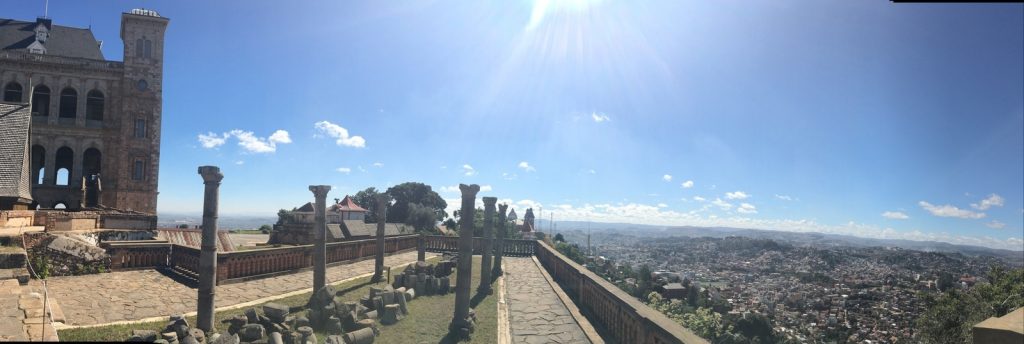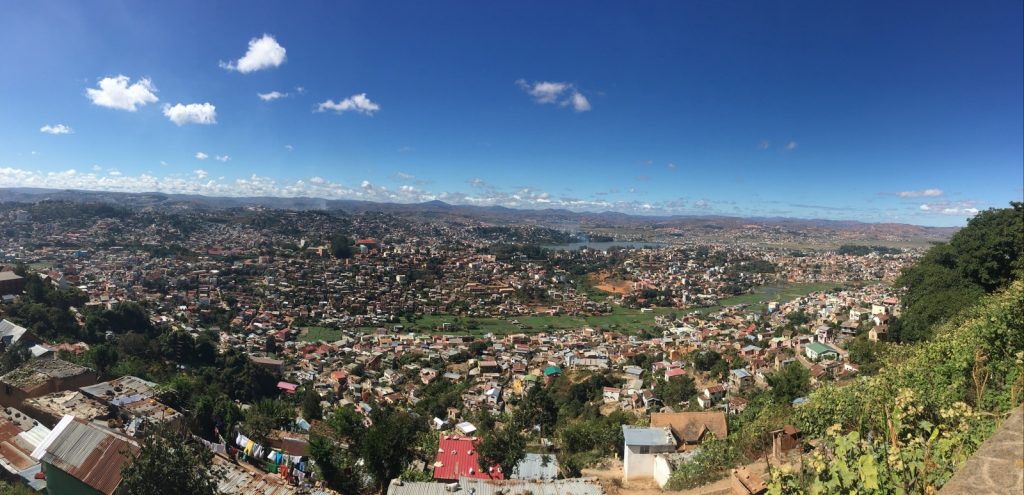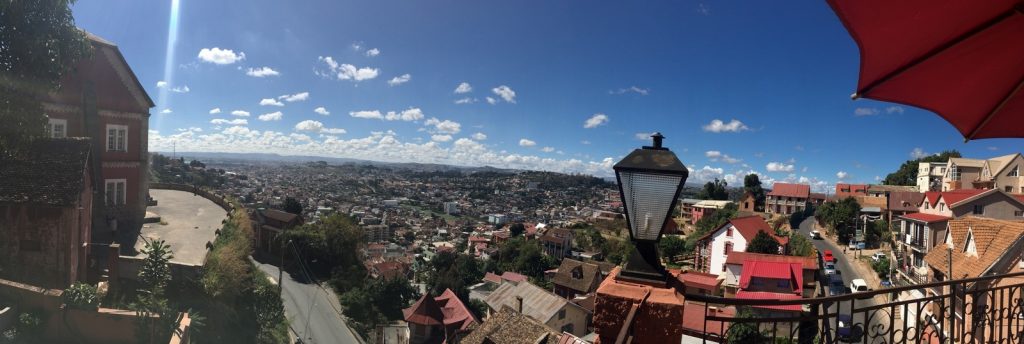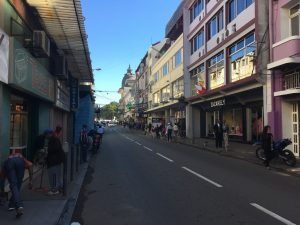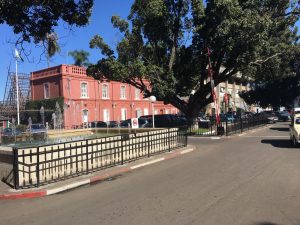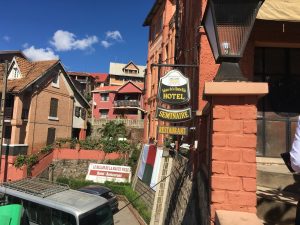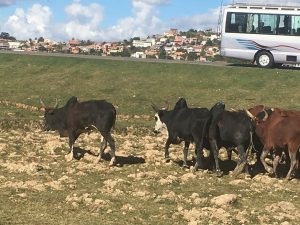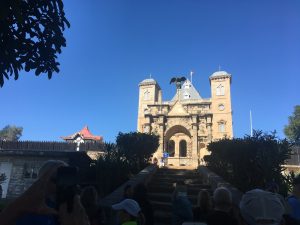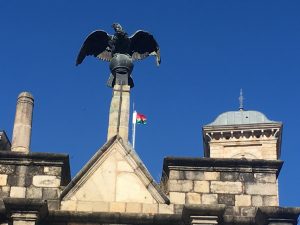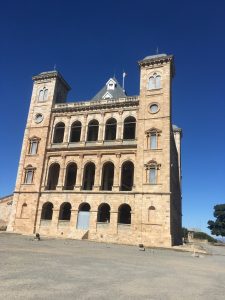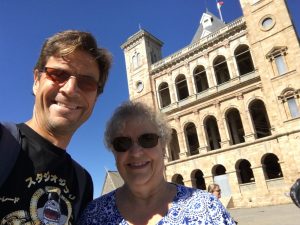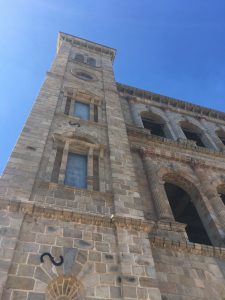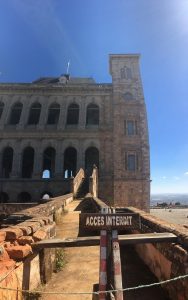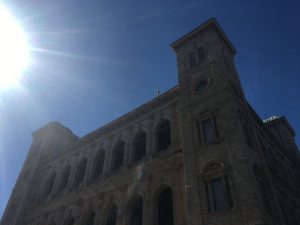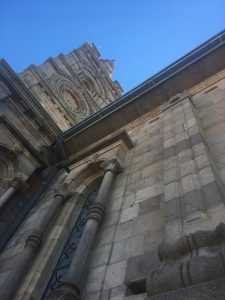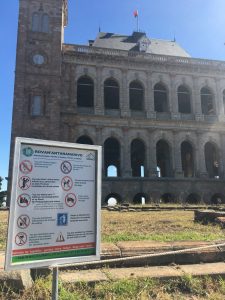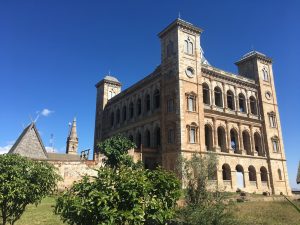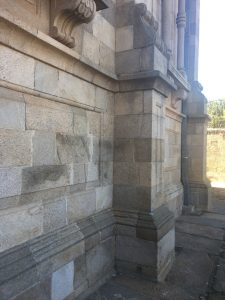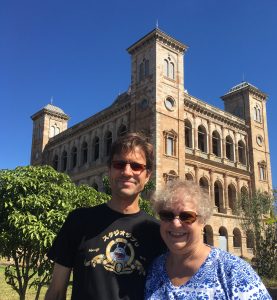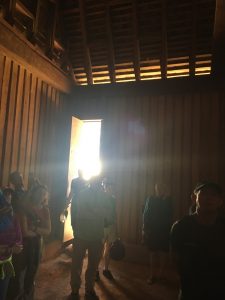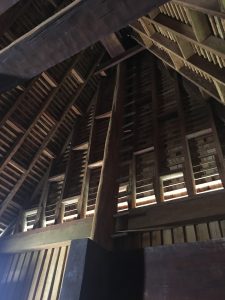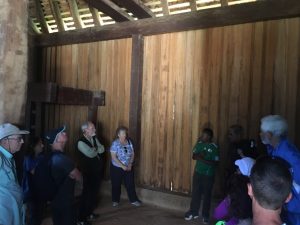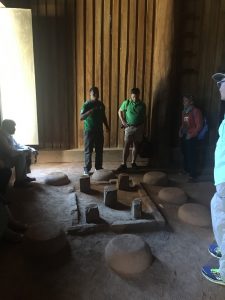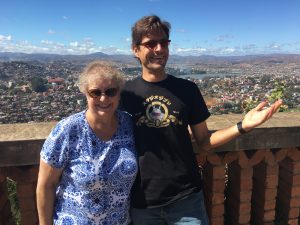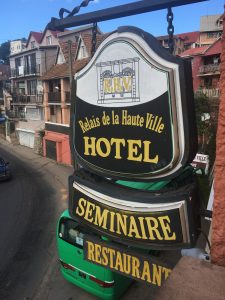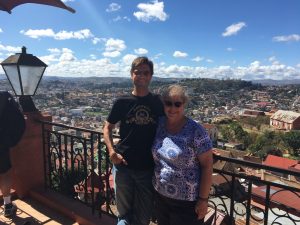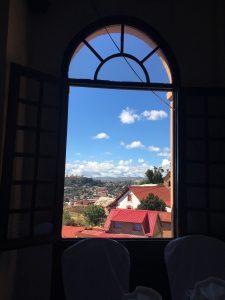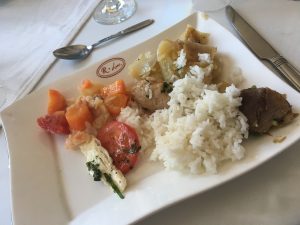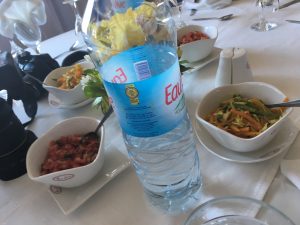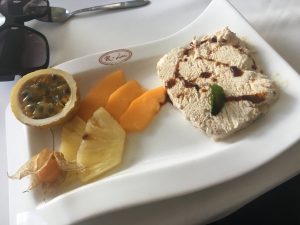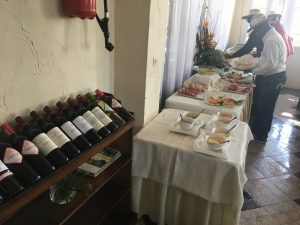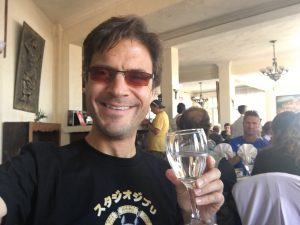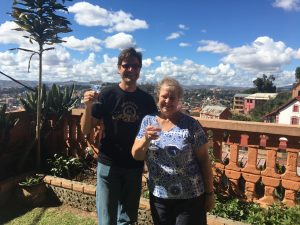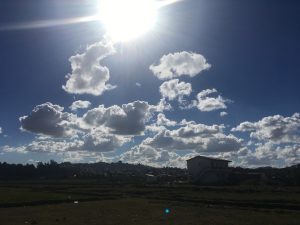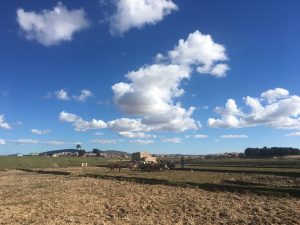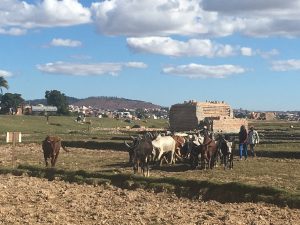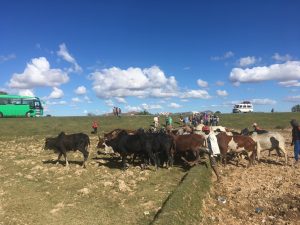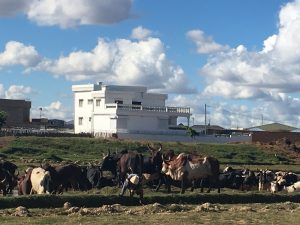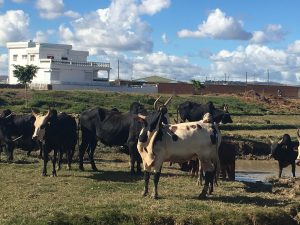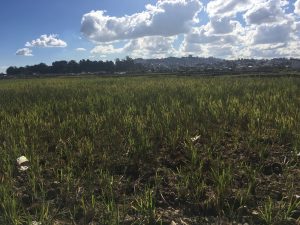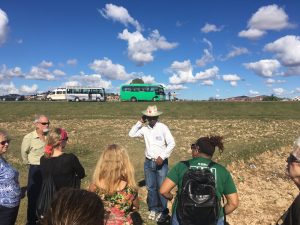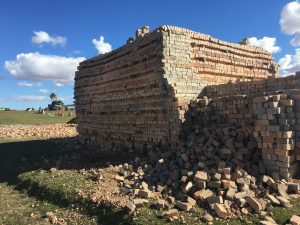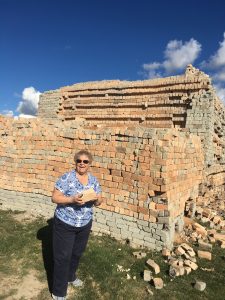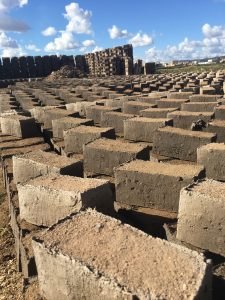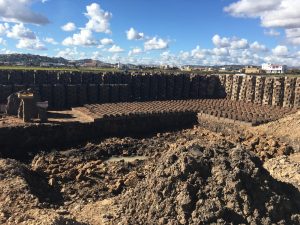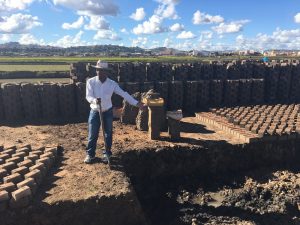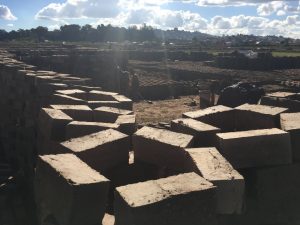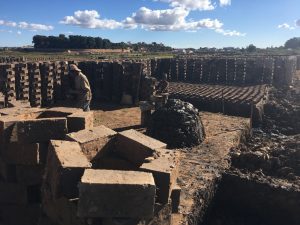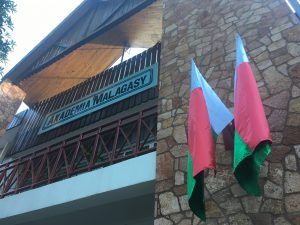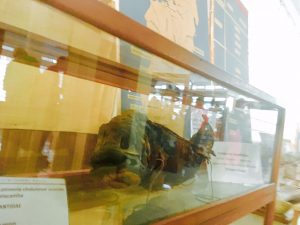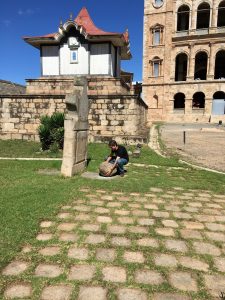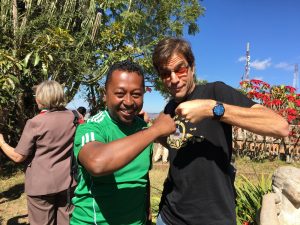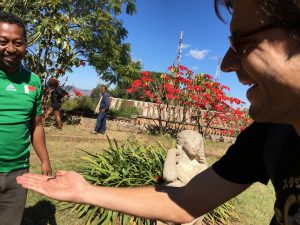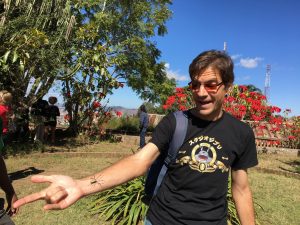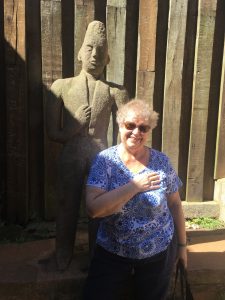Our city tour was slated to include the Queen’s Palace in the morning, a buffet lunch, and the Malagasy Academie natural history museum in the afternoon. Along the way, traveling through the streets of Tana, one couldn’t help but feel the first world guilt of plenty and waste, passing by masses hawking wares or begging coins from tourists. Eco-Tourism is big business in Madagascar, as is the mining of its natural resources. But it seems only some are benefiting from the former, and the latter is the very model of exploitation by foreigners. It’s a sobering, humbling visit and tour, though there is much beauty and joy to be found.
The Malagasy way is mora, mora (slowly, slowly) which was explained as a variation of “island time” or “Hakuna Matata” — a no worries philosophy that is part cultural and part necessity. It’s necessary because if the people really thought about the problems and issues facing themselves it might drive them mad. Because so much seems oppressively overwhelmingly stacked against them. Or such was the impression Lalah our guide gave me in his talks. It wasn’t a world of depressing hopelessness, but there is little doubt that this place is amongst the poorest in the world.
Apparently only 5% of the population has electricity, albeit there’s quite a bit of cannibalization of power lines leading to fire hazards galore. But even taking into account the illegal tapping into the grid, the percentage is tiny. The water as we’re well aware is not potable so bottled water is mandatory. We’ve been warned by other travelers in our group that their faucets were spouting orange H20 and people keep telling us it’s not safe to brush your teeth with tap water. I don’t know — I can’t imagine the swishing and rinsing out of toothpaste is any more water in my mouth than what might happen whilst showering and nobody has advised against that yet.
Our tour guide for the day is Lalah, which in Malagasy means “honey.” He’s a good guide, proffering insights and facts and figures. His English isn’t perfect and he apologizes at the get-go, saying it’s very Malagasian to apologize. But his English is so much better than my French and Malagasy — I’m always impressed with folks who know multiple languages as I struggle with just my one. His full name is unpronouncable to me, having as many letters and phrasings as that infamous Hawaiian fish (ya know, humuhumunukunukuapuaa). I won’t even try and spell Lalah’s name, not even phonetically, but he did tell us that it’s literal translation is “one who is an expected king.” No pressure there, huh? He was the first born son, the oldest, and his mom thought it proper. But seriously, no pressure there, huh?
Malagasy is an oral tradition and when it came to written language, it started as a derivation of Arabic and then went to Latin roots with evangelicals and French took over during colonial rule. There are only 21 characters in the Malagasy written language now, so you won’t find… shoot, Lalah told us and I didn’t scribble that down. But ya know what happens when you google “malagasy alphabet?” You get a wikipedia entry that says there’s 29 characters! So, um, huh. As is often the case with tour guides, sometimes you have to wonder how much is true and how much is legend. But I would think Lalah would know better than the internet. He’s a local.
Our first stop was the Queen’s Royal Compound that features a gate designed by James Cameron… “not the film director,” Lalah told us. Rather a 19th century guy. The eagle on top of this gate was a present from Napoleon in the 1830s.
The royal palace was originally built out of wood and later a facade of bricks were built on top of it. But the entire place was burned down in 1995, the cause a mystery to this day. If it was criminal, there’s no evidence to point to the culprit. But given the rate of burn and the damage inflicted, not only in the palace itself but surrounding areas, there’s plenty of suspicious circumstances.
The palace is the highest point in Tana, rising 1463 meters above sea level. It’s one of 12 sacred hills in the area.
Astrology played a big role, and still does, in Malagasy society. It’s similar to the feng shui and chi concepts of Asia, with good fortune calling for the eastern part of buildings to be closed and western to be the window/entry points. Part of this is the sun is stronger in the morning and it’s better to have it come in to the house later in the day. The house itself becomes one giant sun dial for telling time; at night, the sounds of the animals cue the listener to the hour, e.g. the frogs croak en masse at 2 AM, the first cock crows at 3 AM, all the cocks crow at 4 AM, etc.
A typical house from that era (and in a theoretical sense to this day) was supported by three pillars as load baring, and the open floor plan of the house was divided into four corners. The NorthEast corner was the most sacred and considered the place of one’s ancestors. When entering a house then, as now, one should step in using one’s right foot, as this symbolizes friendship and support. It’s a non-verbal communication that matters in Malagasy culture, and honestly there’s quite a few cues that we learned in a very short amount of time. It’s impolite to point with your fingers; better to point with a knuckle or an open hand. When leaving a house, one should never turn one’s back to the host as it indicates you have turned your back and do not like the host; better to step backwards out of the house in a sign of respect. At celebrations and big events, the first drink is poured into a cup and placed in the Northeast corner to show respect to ancestors. One should also share Zebu meat and an offering to the ancestors is tradition in celebrations and funerals as a sign of respect; with guests the sharing of the zebu at an event shows friendship and kinship.
As we wandered about the house of royalty, my favorite story involved the security system for dinner guests visiting the king. Not only is the doorway narrow so as to ensure only one person enters or exits at a time, but on top of that the King wouldn’t even attend the state dinner! Instead, he would climb into the upper tiers of the building while the Queen would meet visitors and dine with them. If the king didn’t like the visitors, he’d drop a pebble on his wife’s head to tell her so; no pebble means the King would join them after dinner and meet them. There’s something about the princess and the pea or the Girl with the Golden Hair opera with somebody on an upper tier sending signals to down below that I just found fascinating.
Speaking of fascinating, for the longest time the Malagasy people wouldn’t eat eggs because eggs looked like the number zero and therefore were nothing. The people have come around on the incredible, edible egg but to this day you can’t buy eggs directly from someone — at a market or store, the eggs have to be placed on a table by the seller and then picked up by the buyer so as to trade for something and thus to avoid trading “nothing.”
Speaking of not nothing, our lunch was a buffet of various mix-ins with rice. The fish balls were terrible. The pork… or was it zebu… was pretty good but I think my favorite were the mixed veggie slaws and potatoes. Of course, one of our table mates advised us that any veggie that is washed should probably be avoided as it’s washed in the non-potable water and thus may lead to food poisoning. Instead we should focus on skin vegetables that we can peel and cooked items. She did say that we were in higher class restaurants so we were probably okay. It was both helpful and akin to that scene in Temple of Doom — she might as well have said, “AH! Chilled monkey brains!”
The afternoon section of the tour started well and then kinda went off the rails.
We started well with a visit to a rice paddy and a brick manufacturing field. Amidst the recently cultivated rice fields, a herd of zebu were being ushered back and forth for grazing.
The zebu is life in Madagascar — there’s a malagasy saying that I couldn’t spell but is translated to mean “with the zebu, nothing is lost.” Essentially, they use the zebu for everything they can — transportation, plowing, meat, clothing, tools, etc — it’s an all purpose animal. Especially in the countryside, the zebu is a bank account — the more zebu you have, the wealthier you are. Marriages are won based on trading zebu as a dowry. And despite it being 2017, after the fields are plowed by zebu, rice is cultivated by hand — there is no mechanization and it’s hard, manual labor. It’s back breaking work and a hard, hard life… and may account in part for the short life expectancy of the Madagascar people… even if it has a fairly high standard of “peace” at least according to the Economist annual reports on such things.
It is also hard manual labor in brick making. Digging out the mud and the clay, piling it up, forcing it into the frame of the brick, drying it in the sun with some sand to ensure they don’t stick together, then baking it in a homemade kiln to harden it further and remove all organics. Each brick is valued at approximately 80 malagasy ariary, or 2.5 cents US. That’s a massive amount of work for so little payoff.
The natural history museum at the Malagasy Academy was an echo chamber and with divided tours all talking at once, it was like listening to multiple radio broadcasts on two second delays reverberating around. I already have trouble localizing sound in the best of conditions but here it was downright impossible. I did however appreciate seeing one of apparently five examples of a living fossil on earth (Madagascar supposedly has 2 of them in fact). Here’s a missing link between fish and amphibians that is still alive and lurking the deepest darkest waters; it’s so rare to catch that the natives called it the ghost fish. Technically there were no photos in the museum but I smuggled out a shot because frankly I couldn’t hear what was being said anyway and I plead arrogance… er, I mean, ignorance. Also, I wasn’t the only one snapping photos against the rules. But I at least tried to do it on the down low.
***
Here are a few final notes from the day, ones that I wanted to include but wasn’t entirely sure where to put them. Usually you can hide things in the middle… I think Joan Didion said that once about writing. But I’m opting to put it at the end. That makes me sound like I know more than Joan Didion. To be clear, I do not. But I can’t figure out where to hide these in the middle, so… what can you do?
Madagascar is the center of the world.
Did you know that? If you’re a fan of Alfred Wegener, you probably did and didn’t realize it. Back during Pangea, Madagascar was built out of colliding continents… and when Gondwana broke apart, Madagascar pushed India out, Antarctica out, Australia out; it had already pushed South America away. And Madagascar stood alone.
Over 5% of the world’s taxonomy is found here, and 80% of its flora and fauna is endemic to the island. Having survived on its own for 100 million years, humans only turned up and really started to mess things up ecologically 1800 years ago. Since then, and predominately of late, species have gone extinct and over 90% of the island has been deforested in slash-and-burn efforts.
You can talk about distance, but it’s really about time.
Like Los Angeles, distances aren’t really helpful when describing travel here in Australia. It’s all about how long to get there. Depending on traffic in town center, 2 miles could take two hours. Tomorrow we’re to fly on Air Madagascar (sometimes known as Air Maybe due to its notorious flight delays and inconsistency of service) to a spot that takes 2 hours to get to… or 28 hours by car. The latter is over rough pothole terrain, potentially washed out “roads” that have more than a few trails of plywood ruts. It’s not about how far it is… it’s about the time to get there. In which case, maybe this is a perfect place to have a marathon.
The Feats of Strength – I’m More a Dudley Moore than a King Arthur
The original name of Tana was as I said yesterday Analamanga or “Blue Forest.” I still don’t know why; our local guide at the Palace was Patrick (who was awesome), and I even asked him but he said something like, “because of all the fake trees” which didn’t make a lot of sense but I just nodded. Admittedly I was distracted because Patrick was also saying that King Andrianjaka deployed a garrison of 1,000 soldiers to capture Analamanga; years later, during the reign of King Andriamasinavalona (1675–1710), it was renamed Antananarivo (“City of the Thousand”) in honor of Andrianjaka’s soldiers.
This king erected a monument to those same men and at its base placed a large rock. To test his recruits mettle, they would have to lift the rock to prove their manliness and worth… and if they could lift it, they would be made a King’s soldier. When he asked if anybody wanted try, there were no takers, so I dropped my backpack and went under the green rope. I figured it was a touristy thing to do and I’d ham it up and make a show of struggling to lift it… turns out there was no need to make a show. It was really, really heavy and the best I could do was roll it a bit. Turns out I’m not soldier material… but I could maybe make it in the army corps of engineers and show them levers and such perhaps…
Spider-Man, Spider-Man. Does Whatever A Spider Can…
Patrick also located a spider to show us — a golden silk orb weaver. They’re like preying mantises that kill their mate after sex… and they can weave webs of such great strength that they can capture birds. The webbing had some serious tensile strength and was sticky beyond all imagination — I had trouble getting it off and not in the “I’m walking into spiderwebs around my house” way that makes you think you have a web on you but is more mental than real. This, there were strands of this stuff wound around my arms… albeit part of that came when I offered to hold the thing. Given the strength of the web, Mom and I both thought it must explain why Spider-Man is able to swing so easily through the urban jungle of New York City.
A Tribute…
My brother, just like me, doesn’t seem to know what to do with his hands when posing for a photo. He very often strikes a pose that has his hand over his heart… whether it’s to remind himself to stand up straight, is a bona fide Bonaparte vogue, or he’s just uber patriotic, I can’t say. But when we spotted this statue, Mom and I thought a Tribute to Steve was in order. So this one’s for you, man:
Things To Ask A Sommelier When Next Afforded the Opportunity
This evening we had an interesting, albeit rushed powerpoint presentation on Madagascar by a local expert. My favorite detail was his description of Madagascarian wines — “they’re not good… but they’re not bad. They’re admirable given how hard it is to produce wine in the tropics.”
I feel like every time I order a wine now I’m going to phrase it as, “I’d like an admirable red, please…” just to see what that brings. Probably Two Buck Chuck… which, the last time I was at Trader Joe’s was going for $2.99. So I guess Charles Shaw is now Three Buck Chuck… which is one buck too many.
Tomorrow… Air Maybe!

